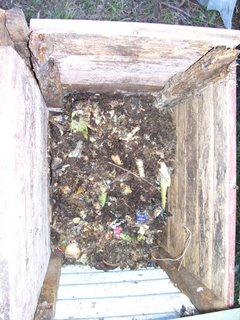 We decided to prepare an automated drip irrigation system.
We decided to prepare an automated drip irrigation system.
Prepare a patch I used cardboard to smother the grass and then built up a raised bed with straw, mulch, and manure.
The 13mm black poly pipe was laid out. I bought a 30 Meter, 4mm drip line from Bunnings that has drippers spaced every 30cm. Another method is to use 4mm pipe to attach to the poly pipe, and put in drippers wherever you want them. I've gone for simplicity this time around.
Above you can see I'm attaching the 4mm dripper line to the 13mm poly pipe. Use hole punches and connectors from hardware shops.
 We put in a few more lines and then it looked like this.
We put in a few more lines and then it looked like this.
 It works too. Dripping succesfully.
It works too. Dripping succesfully.

 A few weeks later it looks like this. From left to right. Zucchini, Onion, Watermelon, Spinach, Cucumber. Zekie is checking on the progress.
A few weeks later it looks like this. From left to right. Zucchini, Onion, Watermelon, Spinach, Cucumber. Zekie is checking on the progress.


Close ups of Cucumber and Spinach. Water is dripping right onto the roots.

It worked so well we prepared another drip irrigation veggie patch. Planted out with Rockmelon, Onion, Tomatoes and Capsicum.
This time the drippers were put under the mulch. Should have done that last time. The drip line is all on an automatic watering system to go for a few minutes of drips at 8am and 8pm. Too easy!







 Through the door and into a hole cut into the balcony
Through the door and into a hole cut into the balcony A gentle slope under the balcony. The pipe is just held up by string
A gentle slope under the balcony. The pipe is just held up by string

 And onto the fruit trees.
And onto the fruit trees. 





























